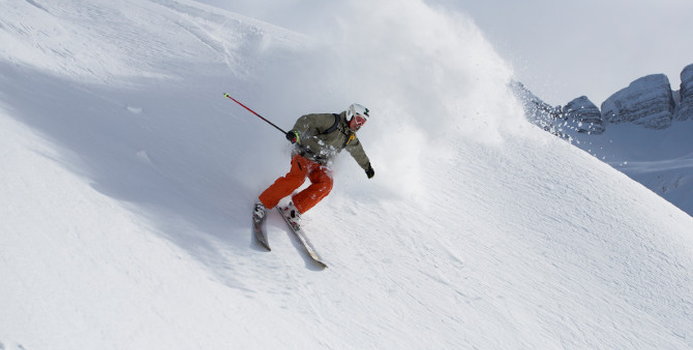Downhill skiing requires both balance and strength. Professional athletes who take part in the sport train throughout the entire year for a number of events, while casual skiing advocates often throw on a pair of skis for only a few quick runs altogether. Knowing how to properly stretch and prepare the body before taking part in any level of the sport will drastically improve performance and reduce the chances of serious injury or bodily harm.
Dry-Land StretchingA number of stretches will take place without the skis or boots. These exercises help loosen the core of the body and simulate the effects that commonly take place during the downhill experience.
Dry Land Stretch #1. Find an even surface that runs perpendicular to a wall. With feet spread shoulder-width apart, point them straight ahead so that six inches to a single foot remain between the wall and your toes. Place both hands as high as they will reach on the wall and slightly arch the lower back.
Hold this extended position without lifting the feet off the ground. Maintaining this position helps loosen the back muscles while lengthening the core. The overall objective of this stretch is to lessen the chance of a back strain while skiing.
Dry Land Stretch #2. Sit on a flat surface and extend both legs out as far as they will reach. With ankles touching, reach toward the inside of the feet and try to hold on for an extended period of time. Next, reach and hold on to the outside of the feet. Finally, point the toes straight in the air and reach for the top portion of the feet.
Each reaching position targets a different region of the legs. By combining all three together into one series of stretching, the entire group of leg muscles receives a thorough warm up.
Ski StretchingAnother set of stretches will take place with the boots and skis fastened in order to specifically target the most commonly used muscles during the activity.
Ski Stretch #1. With the insides of the skis touching, reach straight down and touch the outsides of the ski boots. Keep both legs fully extended.
This stretch targets the hamstrings and specifically works toward adjusting the body to its new elevated height. The combination of the boots and skis add a small amount of height to everyone who takes part in the sport, thus presenting a different feeling that requires a small and usually unnoticeable learning curve.
Ski Stretch #2. Stand on a flat surface away from any downhill slope. While fastened into the skis place the inner rails together and slowly assume a squatting position. Continue to stand up and squat down repeatedly to stretch the quadriceps muscles as well as the hamstrings.
Perform this stretch multiple times with the skis touching and with the skis approximately shoulder-width apart. Adjusting the width between the skis will help replicate the different positions commonly approached during downhill skiing, including those that take place while turning and stopping.



